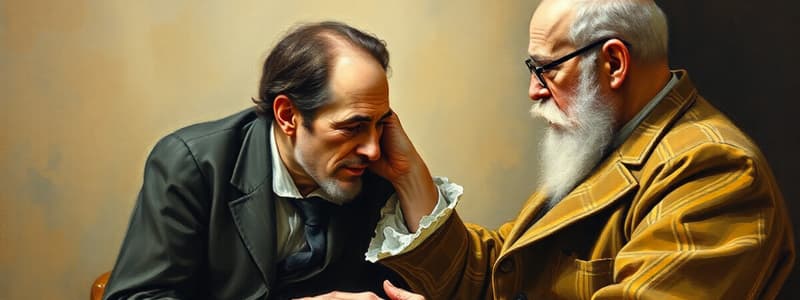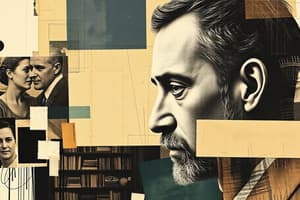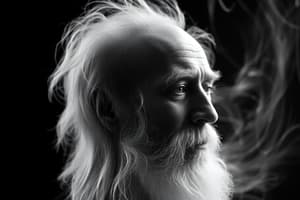Podcast
Questions and Answers
What personality type is characterized by being sociable and sentimental?
What personality type is characterized by being sociable and sentimental?
- Sensation
- Intuition
- Feeling (correct)
- Thinking
Which phase of childhood development is marked by chaotic and sporadic consciousness?
Which phase of childhood development is marked by chaotic and sporadic consciousness?
- Anarchic phase (correct)
- Monarchic phase
- Dualistic phase
- Transitional phase
During which stage of development is the ego characterized by its initial division into objective and subjective?
During which stage of development is the ego characterized by its initial division into objective and subjective?
- Anarchic phase
- Monarchic phase
- Ego phase
- Dualistic phase (correct)
What is a key characteristic of the Intuition personality type?
What is a key characteristic of the Intuition personality type?
At which stage of life does Jung believe that consciousness begins to noticeably diminish?
At which stage of life does Jung believe that consciousness begins to noticeably diminish?
Which personality type is described as adventurous and innovative?
Which personality type is described as adventurous and innovative?
What phase follows the Monarchic phase in childhood development?
What phase follows the Monarchic phase in childhood development?
What personality type seeks pleasure and is described as practical and hands-on?
What personality type seeks pleasure and is described as practical and hands-on?
What role do archetypes play according to Jungian psychology?
What role do archetypes play according to Jungian psychology?
Which archetype represents the feminine side of men?
Which archetype represents the feminine side of men?
What is the symbol associated with the self archetype?
What is the symbol associated with the self archetype?
What does the shadow archetype represent?
What does the shadow archetype represent?
Which archetype is described as the image of a conqueror with a fatal flaw?
Which archetype is described as the image of a conqueror with a fatal flaw?
What is the process of self-realization in Jungian psychology?
What is the process of self-realization in Jungian psychology?
Which of the following is NOT one of Jung's four famous archetypes?
Which of the following is NOT one of Jung's four famous archetypes?
What does the term 'collective unconscious' refer to?
What does the term 'collective unconscious' refer to?
What major attitudes of personality did Carl Jung first distinguish?
What major attitudes of personality did Carl Jung first distinguish?
Which of the following correctly lists Jung's basic functions of personality?
Which of the following correctly lists Jung's basic functions of personality?
What term did Jung use to refer to the things shared with other human beings from our pasts?
What term did Jung use to refer to the things shared with other human beings from our pasts?
What does the personal unconscious contain according to Jung?
What does the personal unconscious contain according to Jung?
What did Jung classify the eight personality types from?
What did Jung classify the eight personality types from?
What connection do the characters Sigmund Freud, Carl Jung, and Sabina Spielrein have in the story?
What connection do the characters Sigmund Freud, Carl Jung, and Sabina Spielrein have in the story?
What did Otto Gross influence Jung to do?
What did Otto Gross influence Jung to do?
What are ‘complexes’ as defined by Jung?
What are ‘complexes’ as defined by Jung?
What is the primary source of tension related to needs?
What is the primary source of tension related to needs?
Which of the following best describes anxiety in terms of tension?
Which of the following best describes anxiety in terms of tension?
How is excess energy related to satisfying general needs described?
How is excess energy related to satisfying general needs described?
What is the most basic interpersonal need highlighted in the content?
What is the most basic interpersonal need highlighted in the content?
What distinguishes disjunctive dynamisms from conjunctive dynamisms?
What distinguishes disjunctive dynamisms from conjunctive dynamisms?
What happens when an infant lacks food according to the content provided?
What happens when an infant lacks food according to the content provided?
How does Sullivan characterize the presence of anxiety?
How does Sullivan characterize the presence of anxiety?
What role do childhood friendships play in the formation of personality?
What role do childhood friendships play in the formation of personality?
What did Carl Jung believe in that refers to emotionally charged associations?
What did Carl Jung believe in that refers to emotionally charged associations?
What primarily caused the end of the relationship between Freud and Jung?
What primarily caused the end of the relationship between Freud and Jung?
How long did Jung and Freud collaborate before their professional separation?
How long did Jung and Freud collaborate before their professional separation?
How did Freud describe Jung's position in relation to him early in their collaboration?
How did Freud describe Jung's position in relation to him early in their collaboration?
What evidence did Jung provide to Freud that fascinated him during their collaboration?
What evidence did Jung provide to Freud that fascinated him during their collaboration?
What year did Freud propose to abandon personal relations with Jung?
What year did Freud propose to abandon personal relations with Jung?
How did Jung feel about the study of the unconscious as presented by Freud?
How did Jung feel about the study of the unconscious as presented by Freud?
Which of the following statements was allegedly made by Freud in his letter regarding Jung's behavior?
Which of the following statements was allegedly made by Freud in his letter regarding Jung's behavior?
What is the primary purpose of Jung's dream analysis method?
What is the primary purpose of Jung's dream analysis method?
Which method did Jung develop that requires a person to focus on an impression until it begins to 'move'?
Which method did Jung develop that requires a person to focus on an impression until it begins to 'move'?
What is the ultimate goal of Jungian psychotherapy?
What is the ultimate goal of Jungian psychotherapy?
What significant experience did Harry Stack Sullivan have at the age of 8?
What significant experience did Harry Stack Sullivan have at the age of 8?
According to Sullivan, how is personality primarily shaped?
According to Sullivan, how is personality primarily shaped?
The Word Association Test (WAT) primarily aims to elicit what kind of reaction?
The Word Association Test (WAT) primarily aims to elicit what kind of reaction?
What age range does the provided content suggest as significant in terms of self-realization and development?
What age range does the provided content suggest as significant in terms of self-realization and development?
Which of the following statements best describes Sullivan's view on intimacy?
Which of the following statements best describes Sullivan's view on intimacy?
Flashcards
Personality
Personality
A person's unique and enduring pattern of thoughts, feelings, and behaviors.
Extroversion
Extroversion
A focus on the external world, being outgoing, sociable, and interested in people and events.
Introversion
Introversion
A focus on the internal world, being quiet, introspective, and interested in thoughts and feelings.
Conscious
Conscious
Signup and view all the flashcards
Unconscious
Unconscious
Signup and view all the flashcards
Personal Unconscious
Personal Unconscious
Signup and view all the flashcards
Collective Unconscious
Collective Unconscious
Signup and view all the flashcards
Archetypes
Archetypes
Signup and view all the flashcards
Repressed Memories
Repressed Memories
Signup and view all the flashcards
Persona
Persona
Signup and view all the flashcards
Shadow
Shadow
Signup and view all the flashcards
Anima
Anima
Signup and view all the flashcards
Animus
Animus
Signup and view all the flashcards
Self
Self
Signup and view all the flashcards
Jungian Analytical Theory
Jungian Analytical Theory
Signup and view all the flashcards
Complexes (Jungian psychology)
Complexes (Jungian psychology)
Signup and view all the flashcards
Collective Unconscious (Jungian psychology)
Collective Unconscious (Jungian psychology)
Signup and view all the flashcards
Archetypes (Jungian psychology)
Archetypes (Jungian psychology)
Signup and view all the flashcards
Individuation (Jungian psychology)
Individuation (Jungian psychology)
Signup and view all the flashcards
Freud-Jung relationship
Freud-Jung relationship
Signup and view all the flashcards
Jung's focus on the unconscious
Jung's focus on the unconscious
Signup and view all the flashcards
Dream interpretation (Jungian psychology)
Dream interpretation (Jungian psychology)
Signup and view all the flashcards
Thinking Type
Thinking Type
Signup and view all the flashcards
Feeling Type
Feeling Type
Signup and view all the flashcards
Sensation Type
Sensation Type
Signup and view all the flashcards
Intuition Type
Intuition Type
Signup and view all the flashcards
Childhood Stage
Childhood Stage
Signup and view all the flashcards
Youth Stage
Youth Stage
Signup and view all the flashcards
Middle Life Stage
Middle Life Stage
Signup and view all the flashcards
Old Age Stage
Old Age Stage
Signup and view all the flashcards
Word Association Test
Word Association Test
Signup and view all the flashcards
Active Imagination
Active Imagination
Signup and view all the flashcards
Jungian Dream Analysis
Jungian Dream Analysis
Signup and view all the flashcards
Sullivan's Interpersonal Theory
Sullivan's Interpersonal Theory
Signup and view all the flashcards
Personality is Shaped by Relationships
Personality is Shaped by Relationships
Signup and view all the flashcards
Intimacy
Intimacy
Signup and view all the flashcards
Jungian Therapy
Jungian Therapy
Signup and view all the flashcards
Social Context and Personality
Social Context and Personality
Signup and view all the flashcards
Tenderness: A Basic Interpersonal Need
Tenderness: A Basic Interpersonal Need
Signup and view all the flashcards
Energy Transformation
Energy Transformation
Signup and view all the flashcards
Dynamisms: Behavior Patterns
Dynamisms: Behavior Patterns
Signup and view all the flashcards
Disjunctive Dynamisms
Disjunctive Dynamisms
Signup and view all the flashcards
Malevolent Dynamisms
Malevolent Dynamisms
Signup and view all the flashcards
Conjunctive Dynamisms
Conjunctive Dynamisms
Signup and view all the flashcards
Intimacy: Deep Connection
Intimacy: Deep Connection
Signup and view all the flashcards
Tension: Potential Energy
Tension: Potential Energy
Signup and view all the flashcards
Study Notes
Psychodynamic Theories: Jung and Sullivan
- Jung's Analytical Theory
- Jung believed in "complexes," emotionally charged associations.
- He collaborated with Freud but disagreed on the sexual basis of neuroses.
- Born July 26, 1875, in Kesswil, Switzerland.
- Son of a Protestant clergyman, Paul and Emilie.
- Worked with Freud for 6 years (1906-1913), and was considered Freud's successor.
- Relationship between Freud and Jung
- The relationship began as a father-son type, with Jung deeply interested in Freud's work
- Freud's word association tests were a key factor in Jung's theory development
- Their relationship eventually ended due to intellectual, professional, and personal reasons.
- Freud expressed that their personal relationship should end due to past disappointments.
Jung's Personality
- Personality is divided into extroversion and introversion.
- Recognized four basic functions: thinking, feeling, sensing, and intuiting.
- These functions, combined with attitudes, create eight personality types.
Levels of the Psyche
- Composed of a conscious and unconscious mind.
- The unconscious is further divided into the personal and collective unconscious.
- The personal unconscious contains suppressed memories, thoughts, and feelings.
- The collective unconscious contains universal, inborn models of people, behaviors, or personalities that affect human behavior; archetypes.
Archetypes
- Universal, inborn models of people, behaviors, or personalities.
- Four famous archetypes: Persona (the side of personality we show to others), Shadow (the dark side of personality), Anima/Animus (feminine/masculine side of men/women) and Self (the unified consciousness and unconsciousness of an individual).
- Examples of archetypes: Great Mother, Wise Old Man, Hero
The Self
- The Self represents fulfillment, completion, or perfection.
- The most comprehensive of all the archetypes, uniting the others.
- Symbol is the mandala.
Dynamics of Personality
- Causality and Teleology: Present events are motivated by goals in the future, as well as by past experiences.
- Progression and Regression: Outside world adaptation involves backward flow of psychic energy, and inner world adaptation involves forward flow.
Psychological Types
- Attitudes: readiness of the psyche to act or react to a situation. Often come in pairs, one conscious and the other unconscious. Introverts focus on inner reflection; Extraverts engage with the outer world.
- Functions: Cognitive mental processes relevant regardless of situation. Combining attitudes and functions creates 8 types of orientations. Thinking, feeling, sensation, and intuition are the four key functions.
Jung's Methods of Investigation
- Word Association Test: Subjects respond to words with the first word that comes to mind to uncover unconscious feelings.
- Dream Analysis: Jungian interpretation uncovers themes from the personal and collective unconscious, aiding self-realization.
- Active Imagination: Engaging with impressions (images, visions) until they begin to move, to explore the unconscious.
- Psychotherapy: Guiding neurotic patients toward healthy states and encouraging healthy people to work towards self-realization.
Harry Stack Sullivan: Interpersonal Theory
- Sullivan was born Feb. 21, 1892, and trained in America.
- Developed a theory emphasizing relationships, and the significance of childhood friendships.
- Sullivan believed personality was not separate from social interactions.
- Key concepts: Chumship, intimacy, and security.
Tension: Needs and Anxiety
- Tension: a state of imbalance between the person and the environment, leading to action.
- Arises from needs(basic needs and zonal needs), and anxiety. Needs can include biological ones like hunger as well as basic needs for psychological safety and security.
- Anxiety: a disjunctive tension, requiring no specific action for relief. considered a very disruptive factor in healthy interpersonal relationships; more detrimental to a person than tension without feeling of anxiety.
Energy Transformations and Dynamisms
- Energy transformations: are tensions translated into actions, overt or covert, to satisfy needs/reduce anxiety.
- Dynamisms: organized patterns of behavior, traits, or habits. Three categories: disjunctive (destructive), isolating (self-centered), and conjunctive (intimacy-oriented).
- Types of Dynamisms: Malevolence, Intimacy, and Lust.
Personifications
- Are feelings and attitudes toward a person that stems from interpersonal relations.
- Used to maintain emotional equilibrium, reducing anxiety by categorizing aspects of the self or others into "good" or "bad."
- Include Bad-Mother/Good-Mother, Me, and Eidetic Personifications.
Persona, Development Stages
- Childhood: The early stages, full of potential but lacking in brilliance. Sub-stages include anarchic (chaotic), monarchic (ego and logical thinking), and dualistic (objective and subjective differentiation of the self).
- Youth: Climbing toward the zenith, aware of impending decline.
- Middle life: Early afternoon sun, radiant but aware of being in decline.
- Old age: Evening sun, consciousness dimming.
- Developmental Challenges: Interpersonal challenges vary across each stage of development.
- Personality development: Evolves from infancy through adulthood.
Other
- References include a publication, Theories of Personality.
Studying That Suits You
Use AI to generate personalized quizzes and flashcards to suit your learning preferences.




